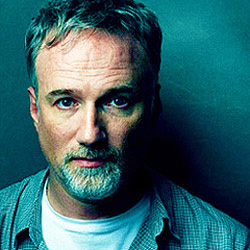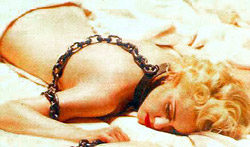
David Fincher & Citizen Kane
David Fincher has risen to become one of the most respected filmmakers in the industry. With a career built on creating thought provoking films with a strong visual flair, his work is unmistakable.
Whether it’s the claustrophobic Alien 3 (1992), the noir-like Seven (1995), the mind-warp of Fight Club (1999), the super-sleek Panic Room (2002) or the court-room/internet drama of The Social Network (2010), you know you’re in the world of Fincher. There’s just something about the way a room is lit, framed and shot. Not only that though, it’s in way the camera tilts at angles, or the way a scene fades out or dissolves into another. Yet his skill as a filmmaker is not limited to feature films, but also television commercials and music videos.

David Fincher, Vanity Fair
Fincher’s love for this art form took off when he began shooting on 8mm as a teenager. Inspired by films like Butch Cassidy and the Sundance Kid (1969), the youngster could have gone to film school after graduating from Ashland High School in Oregon but instead he got himself a job with Korty Films as a camera-loader.
Luckily, in 1983, this lead to working with a little company called Industrial Light & Magic where he got some hands-on experience with films like Twice Upon a Time (1983), Star Wars: Return of the Jedi (1983), and Indiana Jones and the Temple of Doom (1984). A year later Fincher decided to spread his wings and after leaving ILM he directed a commercial for the American Cancer Society which quickly got him some attention as it showed a fetus smoking a cigarette.
In the years that followed, Fincher would go on direct many television commercials for brands such as Revlon, Converse, Nike, Pepsi, Sony, and Levi’s as well as the documentary The Beat of the Live Drum featuring Rick Springfield (1985). With the company Propaganda Films he would also begin directing music videos and this was where he first caught my attention.
As a kid growing up in the 1980’s I was heavily influenced not only by the movies I saw at the drive-ins but also by the videos that played on MTV. I can easily recall the first time I saw Video Killed The Radio Star by The Buggles, Once In A Lifetime by Talking Heads and Money For Nothing by Dire Straits. As I watched music stars embracing this new art form there was one who was quickly shedding her street image and emerging as the Queen to Michael Jackson’s King of Pop status – Madonna.
 Madonna, Like A Prayer, dir. Mary Lambert (1989)
Madonna, Like A Prayer, dir. Mary Lambert (1989)After setting a new standard with her landmark 1986 album True Blue, Madonna had taken a break from the music scene and in 1989 she re-launched herself with Like A Prayer, an album she wrote and produced with Stephen Bray and Patrick Leonard and collaborated on one song with Prince. In March that year she stirred up controversy with her video for the title track, Like A Prayer, directed by Mary Lambert.
Burning crosses, black saints, interracial relationships, race hate crime and sexual ecstasy were all themes on the menu. Religious groups and even Pepsi, who agreed to sponsor her tour if she endorsed their soft drink in an unrelated video featuring the song, were not happy. Yet she walked away with her $5million fee and more publicity for her album than she could have dreamed of, so what more could she want? What more could she do?
Always with her finger on the pulse and with an eye for spotting talent when she sees it, Madonna hired Fincher to direct her next video.
 Madonna, Express Yourself, dir. David Fincher (1989)
Madonna, Express Yourself, dir. David Fincher (1989)Filmed at Culver Studios in Culver City, California, Express Yourself cost a cool $5million to make and was an homage to Fritz Lang’s Metropolis (1927), a futuristic story set in dystopia society that explores the social crisis between workers and owners inherent in capitalism, as expressed by Karl Marx and Friedrich Engels.
Mark Browning picks up on what seems to be the director’s fascination with the Weimar classic from as far as his Rick Springfield Bop Till You Drop video:
While the suggestion for Madonna to go with Metropolis was probably Fincher’s the singer maintained a strong level of control throughout every aspect of the production:
 Madonna, Express Yourself, dir. David Fincher (1989)
Madonna, Express Yourself, dir. David Fincher (1989)Express Yourself doesn’t go as far as depicting Madonna as a saint-like school teacher or her crazed alter-ego, the robot Maria (Brigitte Helm), but it does contain a futuristic city where workers toil away down below while the elite live in luxury up above. In the midst of all of this is Madonna in a sort of dual role. Wearing a pinstripe suit and monocle, with her hair slicked back she stands above the workers on the factory steps while in other scenes she lies naked and chained to a bed, waiting.
Though Fincher had directed a string of music videos for the likes of Sting, Paula Abdul, Roy Orbison, Steve Winwood and Jodie Watley before he got around to Madonna, it’s perhaps his work with her that’s he’s most often associated with as a music video director. After all, Express Yourself, with its sexual imagery, bold colours and sleek style played on every network that could show it despite outrage from parental, religious and feminist groups
Yet for its headline grabbing and calls for it to be banned, it wasn’t that video which brought him to my attention. Madonna then went on to work with fashion photographer and close friend Herb Ritts for Cherish, the third video from her Like A Prayer album, but she would then reunite with Fincher for what seemed like an unlikely choice for a single.
 Madonna, Oh Father, dir. David Fincher (1989)
Madonna, Oh Father, dir. David Fincher (1989)Oh Father was a sombre ballad with a huge orchestral sound that paid tribute to Simon & Garfunkel. It told the story of someone who desperately wanted to be loved by their father but was always pushed away. I loved this song from the first moment I heard it. With its confessional approach it was honest, raw, extraordinarily well produced and still striking beautiful. Yet I never imagined it would be made into a video and released.
Filmed in October 1989 at Culver Studios, the black and white video would homage another classic film. This time Madonna and Fincher chose Orson Welles’ Citizen Kane (1941) and the results were stunning. Largely autobiographical as well, the video revisited a personal tragedy and important moment in Madonna’s life, her own mother’s death.
It’s here that Fincher hones his skills and recreates some of those scenes from Welles’ landmark film to tell Madonna’s story, shifting the genders and POV’s from male to female.
 Madonna, Oh Father, dir. David Fincher (1989)
Madonna, Oh Father, dir. David Fincher (1989)These scenes immediately capture the early scenes from Citizen Kane and with Fincher using seamless cuts we have one story being told from two different times, Madonna past (child) and Madonna (present). As we move through the video we begin to see themes of religion, repression, confession and parent/child struggles come to the surface. For a video that lasts only 4:51 minutes, it’s more than you would expect from your average MTV music artist, and Madonna was trailblazing.
While Browning notes that Fincher’s video benefits aesthetically from the use of extreme high angles, shadows, reverse tracking and dissolving shots to create fluidity between scenes and images, he goes on to say,
 Madonna, Oh Father, dir. David Fincher (1989)
Madonna, Oh Father, dir. David Fincher (1989)I strongly disagree. It’s precisely because of the way the video effectively depicts the relationship between unresolved childhood traumas and how they can go on to affect adult life that I felt a connection with it. Fincher and Madonna embodied something disturbing, unsettling and morbid with Oh Father where we see a woman in her early 30’s trying to make peace finally with things that happened so long ago. How else can we explain this when Vickers also recognises the coherence:
- (1) Mark Browning, David Fincher: Movies That Scar (2010), Praeger Publishers Inc
- (2) Mick St. Michael, Madonna Talking: Madonna in Her Own Words (2004), Omnibus Press
- (3) Nancy Vickers, Materialism and the Material Girl in Embodied Voices, Representing Female Vocality In Western Culture (1996), Cambridge University Press
Oh Father continues to make its way onto many of the world’s Best Music Videos countdown lists even after 20 years. Whether it’s for its aesthetic appeal, the issues it expounds or for its sheer musical brilliance or a combination of all, I would say it’s rightly earned those accolades.
Though Fincher went on to direct two further videos with Madonna, the iconic Vogue (1990) and mini-movie featuring Christopher Walken as a guardian angel, Bad Girl (1993), before moving on to feature films with Alien 3, it’s always this homage to Citizen Kane that I’ll remember as the piece of work that announced his arrival.

Patrick Samuel
The founder of Static Mass Emporium and one of its Editors in Chief is an emerging artist with a philosophy degree, working primarily with pastels and graphite pencils, but he also enjoys experimenting with water colours, acrylics, glass and oil paints.
Being on the autistic spectrum with Asperger’s Syndrome, he is stimulated by bold, contrasting colours, intricate details, multiple textures, and varying shades of light and dark. Patrick's work extends to sound and video, and when not drawing or painting, he can be found working on projects he shares online with his followers.
Patrick returned to drawing and painting after a prolonged break in December 2016 as part of his daily art therapy, and is now making the transition to being a full-time artist. As a spokesperson for autism awareness, he also gives talks and presentations on the benefits of creative therapy.
Static Mass is where he lives his passion for film and writing about it. A fan of film classics, documentaries and science fiction, Patrick prefers films with an impeccable way of storytelling that reflect on the human condition.
© 2022 STATIC MASS EMPORIUM . All Rights Reserved. Powered by METATEMPUS | creative.timeless.personal. | DISCLAIMER, TERMS & CONDITIONS
HOME | ABOUT | CONTACT | TWITTER | GOOGLE+ | FACEBOOK | TUMBLR | YOUTUBE | RSS FEED
CINEMA REVIEWS | BLU-RAY & DVD | THE EMPORIUM | DOCUMENTARIES | WORLD CINEMA | CULT MOVIES | INDIAN CINEMA | EARLY CINEMA
MOVIE CLASSICS | DECONSTRUCTING CINEMA | SOUNDTRACKS | INTERVIEWS | THE DIRECTOR’S CHAIR | JAPANESE CINEMA





